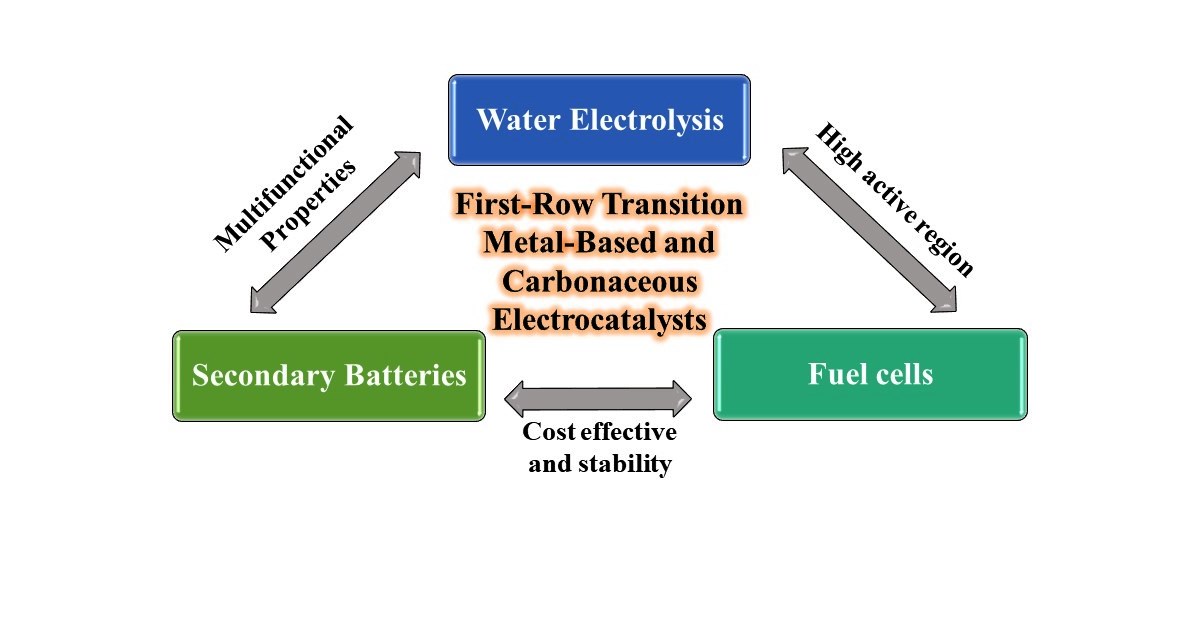- 4.0Impact Factor
- 7.6CiteScore
- 17 daysTime to First Decision
First-Row Transition Metal-Based and Carbonaceous Electrocatalysts for Energy Conversion and Storage Systems
This special issue belongs to the section “Electrocatalysis“.
Special Issue Information
Dear Colleagues,
The global energy landscape is undergoing a profound and necessary transformation toward sustainable, low-carbon technologies to address the dual challenges of climate change and growing energy demand. In this evolving scenario, first-row transition-metal-based and carbonaceous materials have emerged as promising alternatives to noble-metal-based catalysts due to their abundance, low cost, tunable electronic structures, and structural versatility. These materials offer significant potential for driving key electrochemical processes central to renewable energy conversion and storage, including water splitting, fuel cells, metal–air batteries, and carbon dioxide/nitrogen reduction. Their ability to support high catalytic activity, combined with increasing efforts to tailor their morphology, surface chemistry, and electronic properties, makes them central to the development of next-generation energy technologies.
This Special Issue aims to compile the latest scientific and technological advances in the design, synthesis, functionalization, and mechanistic understanding of such materials, with a focus on their integration into practical and scalable electrochemical systems. We seek to provide a platform for showcasing breakthroughs that bridge fundamental insights with real-world applications. We welcome contributions (original research articles, reviews, and short communications) that address, but are not limited to, the following themes:
- Synthesis and characterization of first-row transition-metal-based nanostructures (Fe, Co, Ni, Mn, Cu, etc.).
- MOF-derived or coordination-complex-derived catalysts for electrochemical applications.
- Carbonaceous electrocatalysts, including biocarbon, heteroatom-doped carbons, porous carbon frameworks, and graphene-based materials.
- Hybrid or composite catalysts combining transition metals with carbon supports or conductive scaffolds.
- Electrocatalysis for energy conversion, such as
- The hydrogen Evolution Reaction (HER);
- The oxygen Evolution Reaction (OER);
- The oxygen Reduction Reaction (ORR);
- CO2 and N2 reduction.
- Applications in energy storage systems, such as
- Water splitting;
- Metal–air batteries (Zn-air, Li-air, etc.);
- Fuel cells;
- Electrochemical capacitors;
- Advanced battery chemistries.
- Mechanistic and theoretical studies, including
- Reaction pathway analysis;
- DFT calculations;
- In situ and operando spectroscopic studies.
- Scalability, durability, and system integration of these catalysts in real-world devices.
We encourage the submission of interdisciplinary and application-focused papers that bridge fundamental material science and applied electrochemical engineering.
If you would like to submit papers to this Special Issue or have any questions, please contact the in-house editor, Ms. Rita Lin (rita.lin@mdpi.com).
Dr. Sadhasivam Thangarasu
Guest Editor
Manuscript Submission Information
Manuscripts should be submitted online at www.mdpi.com by registering and logging in to this website. Once you are registered, click here to go to the submission form. Manuscripts can be submitted until the deadline. All submissions that pass pre-check are peer-reviewed. Accepted papers will be published continuously in the journal (as soon as accepted) and will be listed together on the special issue website. Research articles, review articles as well as short communications are invited. For planned papers, a title and short abstract (about 250 words) can be sent to the Editorial Office for assessment.
Submitted manuscripts should not have been published previously, nor be under consideration for publication elsewhere (except conference proceedings papers). All manuscripts are thoroughly refereed through a single-blind peer-review process. A guide for authors and other relevant information for submission of manuscripts is available on the Instructions for Authors page. Catalysts is an international peer-reviewed open access monthly journal published by MDPI.
Please visit the Instructions for Authors page before submitting a manuscript. The Article Processing Charge (APC) for publication in this open access journal is 2200 CHF (Swiss Francs). Submitted papers should be well formatted and use good English. Authors may use MDPI's English editing service prior to publication or during author revisions.
Keywords
- bifunctional electrocatalyst
- water splitting
- batteries
- fuel cells
- hybrid capacitors

Benefits of Publishing in a Special Issue
- Ease of navigation: Grouping papers by topic helps scholars navigate broad scope journals more efficiently.
- Greater discoverability: Special Issues support the reach and impact of scientific research. Articles in Special Issues are more discoverable and cited more frequently.
- Expansion of research network: Special Issues facilitate connections among authors, fostering scientific collaborations.
- External promotion: Articles in Special Issues are often promoted through the journal's social media, increasing their visibility.
- e-Book format: Special Issues with more than 10 articles can be published as dedicated e-books, ensuring wide and rapid dissemination.

